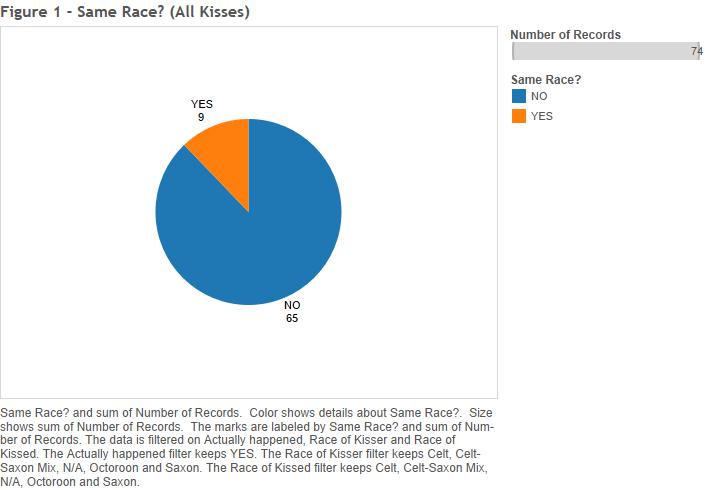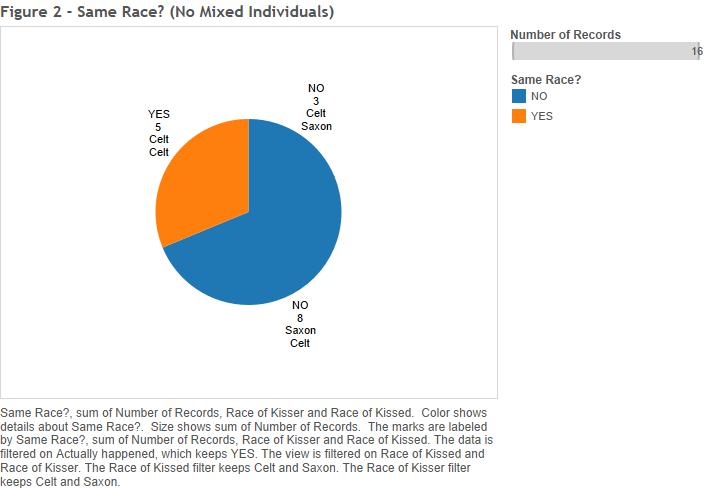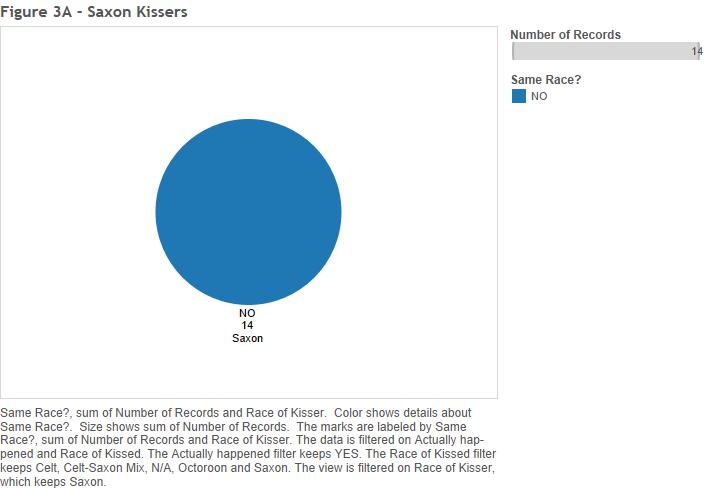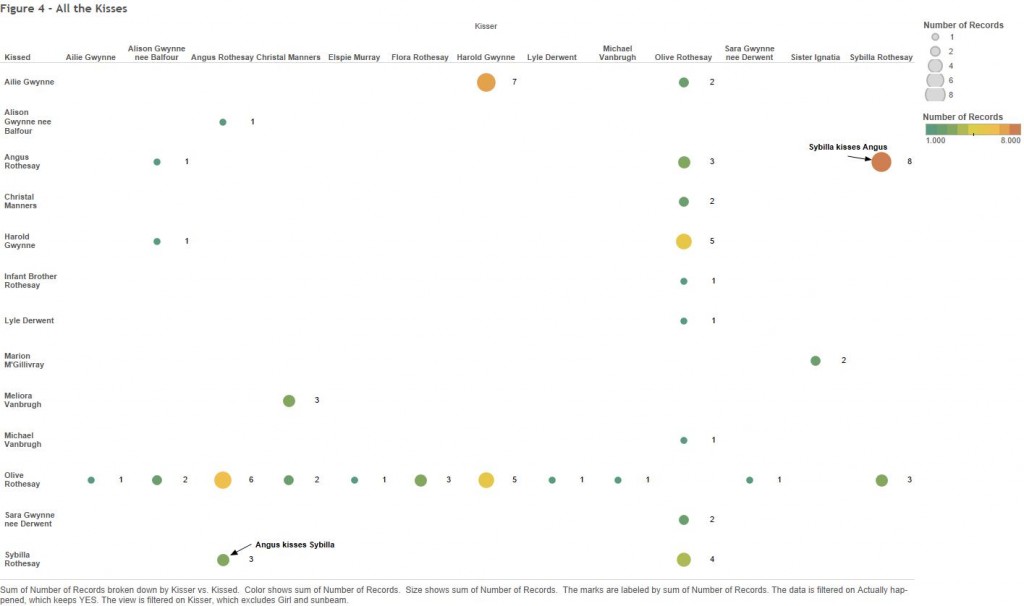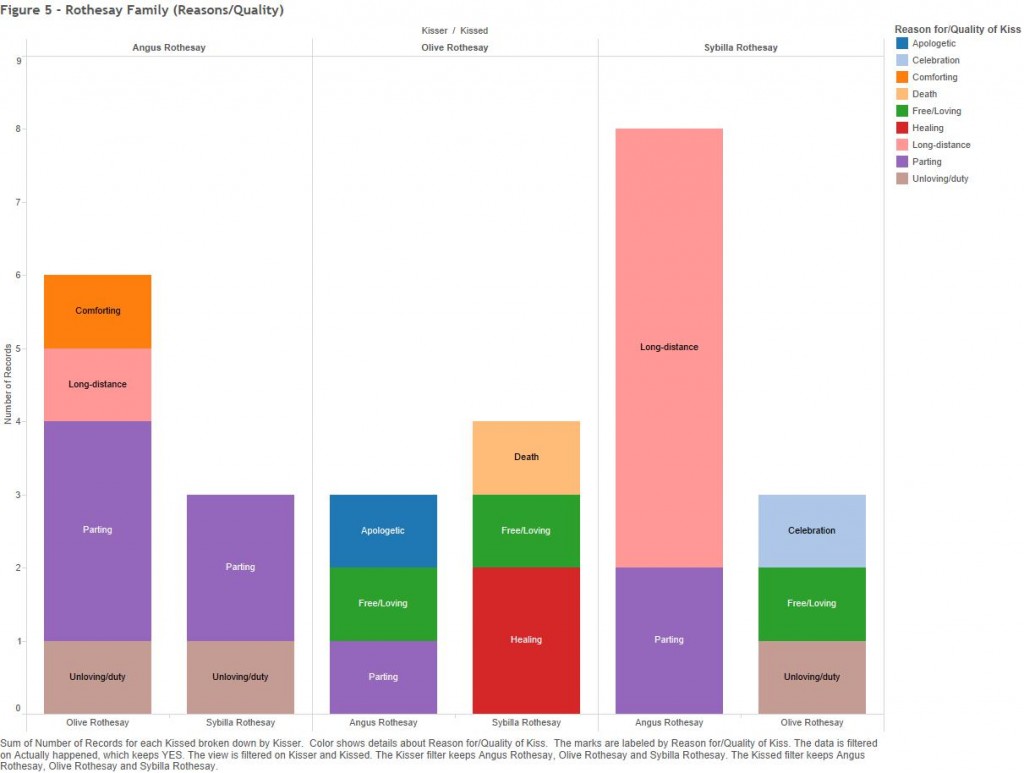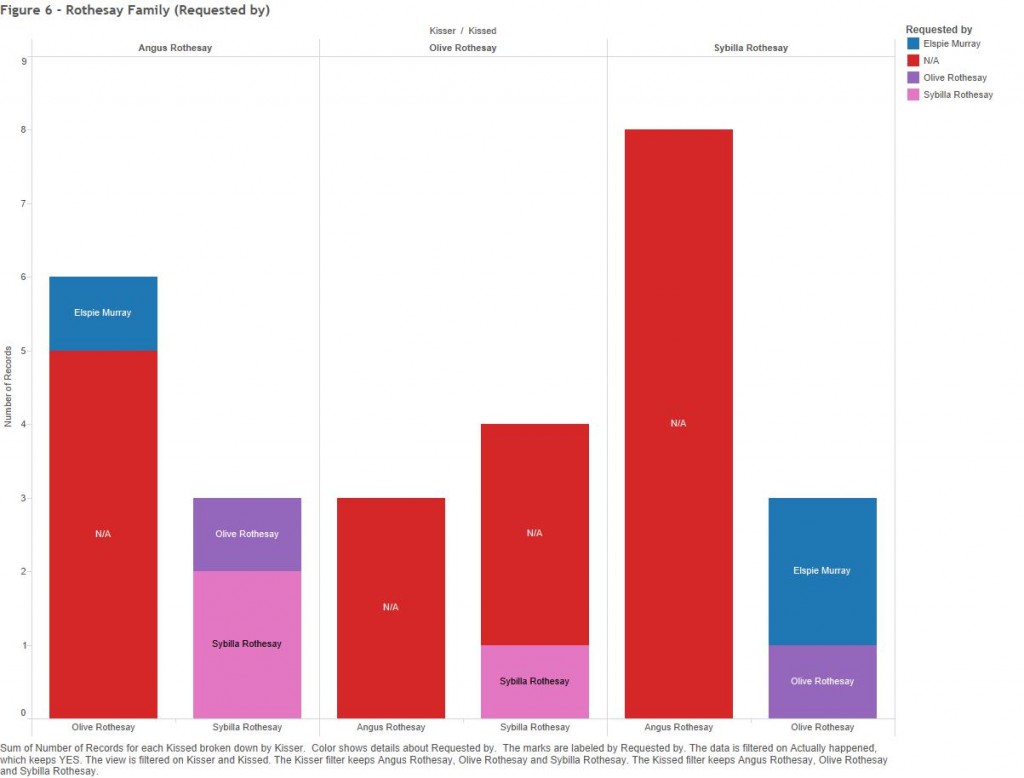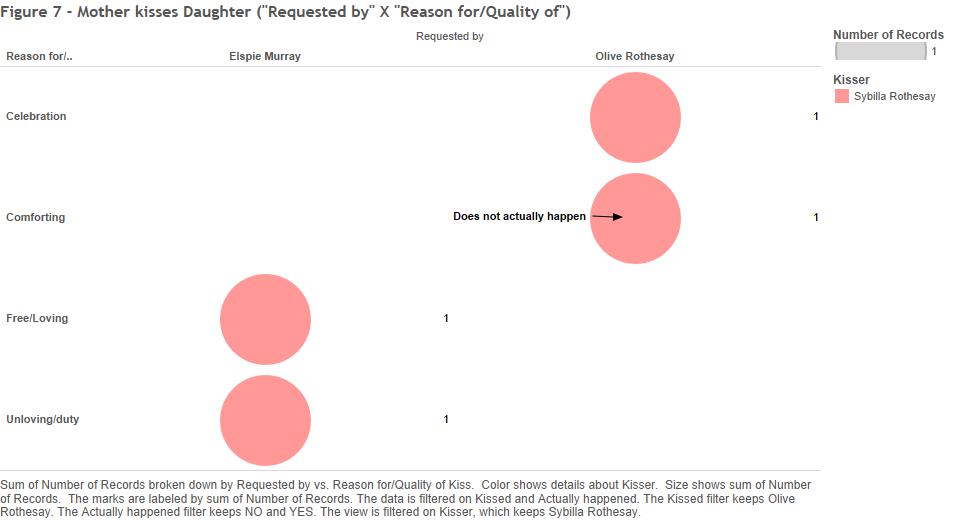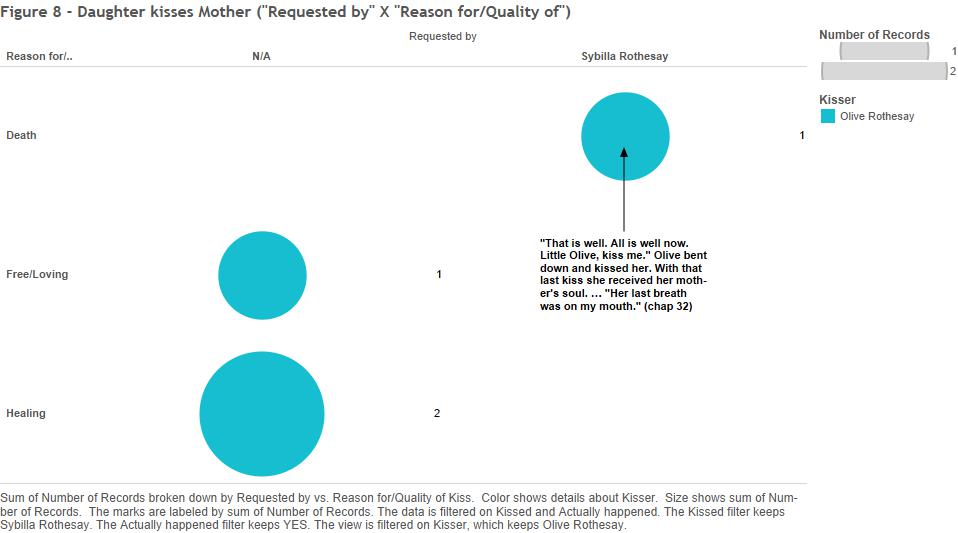Looking at Racial Hybridity through the Kisses of the Rothesay Family
Both Juliet Shields and Alisha Walters offer close-reading interpretations of the interracial couples and mixed offspring in Olive. Both argue that Craik wrote Olive midst racial tension, evidenced in part by Robert Knox’s text published the same year, 1850, as Craik’s novel (Shields 285-86; Walters 326). Some, like Knox were against racial mixing and under the opinion that only Saxons (English or Scottish Lowlands heritage) were British, which thus excluded Welsh, Scottish Highlands and Irish Celts, not to mention peoples in the British colonies, from the national identity (Shields 285; Walters 326). Though argued and nuanced differently, both Shields and Walters show Olive (and the character Olive) as a statement showing the benefits of a racially hybrid conception of Britishness (Walters 326; Shields 297-98).
While it seems somewhat unlikely that the kiss data could speak of the racial qualities within a character,[1] as a kiss is an interpersonal interaction, the kiss data, in general, appears to support the ideas of Shields and Walters, showing a high degree of physical, likely emotionally charged, interaction between races. Figures 1 and 2 show whether the kisses were interracial or kept within one race. All races and racial-mixes are included in the first figure; the mixed-races (Celt-Saxon mix [Ailie and Olive] and Octoroon [Christal]) are filtered out in the second pie chart.
In both cases, kisses between different races outnumber those within one race (or type of racial hybrid). In fact, if limited just to instances with a Saxon kisser and/or Saxon kissed, one can see that every Saxon kiss is an interracial one (figs 3A and 3B).
Thus, if kisses can be used as a pointer towards sexual and/or emotional connection, or what Walters calls “emotive engagement with raced Others” (326), the data indicates that the novel seems to be strongly against Saxon isolationism. Unfortunately, the data does not include anyone who is not a “kisser” or a “kissed”, thus making it impossible to tell if the Saxon and Celt kissers form a majority of the novel’s character “population”. Perhaps gathering that data could add additional support, by informing us whether Craik made her interracial kissers a true majority, rather than just an exceptional minority that she focused the majority of her novel on.
Still, the kiss data can reveal something about the interactions between Craik’s characters, and thus about Craik’s presentation of interracial contact. Looking just at the kisses of the Rothesay family – the Celt Angus, the Saxon Sybilla, and their mixed offspring Olive – reveals a troubled family unit, perhaps indicative of the racial tensions in Craik’s Britain. Shields herself posits such a reading by calling Olive a descendent of “Scottish and Irish novels by women”, which “construct an analogy between the domestic and the national” (288). So, one can read the Rothesay family’s kisses as political or social interaction between Saxons, Celts and hybrids; perhaps showing how Craik saw the situation, and what she hoped for.
So, let us examine the data, beginning with the married couple, through the lens of racial analogy, while cautiously keeping aware of possible interpretive errors. Figure 4 is an overview of every kiss that actually happens[2] in the novel; it shows kissers on the x-axis and kissed on the y-axis. The colour and size of the circles at the intersections of kisser and kissed show how many kisses occurred.
Looking at the far right, one can see that Sybilla kisses Angus eight times – the most times any character kisses another – whereas (bottom row, left) Angus only kisses Sybilla three times. One could thus mistakenly conclude that this unbalanced situation shows a relationship where the Saxon wants integration with the Celt, more than the Celt wants the same. More nuance appears when looking at other elements of the data. Figure 5, limited just to the three Rothesays, groups the data first by kisser, then by kissed, colour coding “the reason for/quality of” the kiss.
Here, one sees that six of Sybilla’s kisses were long-distance.[3] This means that their face-to-face relationship is not as uneven: three kisses to two.[4] Additionally, since Sybilla kissed Angus more often when he was away, one could ask if the data indicates a Saxon desire for what the Celt had to offer Britain that was greater when the Celt was “out of the house”, as it were. Perhaps one could use the fact that four of the couple’s five face-to-face kisses were at partings[5] to support the notion that Craik saw that the two races wanted to be separated. Another nuance to the racial relationship picture comes from looking at which kisses were requested. Figure 6 shows that Angus only kisses Sybilla when asked, whereas Sybilla always kisses him without prompting. This points to a hesitancy on Angus’ part towards the relationship, and by analogous extension of Celts to a relationship with Saxons. A close-reading could connect these data points with Angus being upset by Sybilla’s “deceitfulness” regarding Olive (chap 5)[6], and thus to Celtic wariness towards Saxon “affection”.
Of course, the “requested by” graph (fig 6) also opens up the question of how these two race-exemplars treat their mixed offspring. Angus kisses Olive without request five times, Sybilla never does (fig 6). Does this mean Craik saw Celts as more accepting of hybrid individuals than Saxons were? Further research, perhaps into the author’s letters, could potentially offer answers. Regardless, Figure 6 alone is not conclusive enough about Sybilla and Olive’s kissing relationship – though it shows requests, it does not show how they were answered.[7] Figure 7 shows the “reason for/quality of” each kiss given from mother to daughter, separated by who asks (top names – Elspie or Olive).
Of the three that occur – the comforting one does not clearly happen (see first blog post) – two are rather positive: “free/loving” and “celebratory”. Thus, the data indicates that even though asked the Saxon still cheerfully responded to her daughter; a closer reading would clarify if this was so. Furthermore, out of all the kisses Olive gives Sibylla, the mother asks for one; and the circumstance is Sybilla’s death (fig 8).[8]
So, the Saxon asks the hybrid to kiss her at the Saxon’s death. Given Elizabeth Gitter’s reading of such kisses as the transmission of the soul (165-66), which clearly happens in the text (see fig 8 annotation; chap 32), one could argue that this moment reflects Craik’s hope that the Saxon people would willingly give up their soul (i.e. Britishness) to a more hybrid conception of nation. A close reading could support such a reading, given Sybilla’s movement from rejecting Olive to full acceptance.
The kiss data of the Rothesay family, can be read using an analogy for the British nation, showing tensions between races and distaste towards hybridity. Still, the overall picture that interracial kisses are the norm in the novel, combined with a reading of the final kiss Olive shares with her mother could offer strong evidence for an argument on Craik’s stance in the racial arguments of the day. Thus the kiss data can offer quantitative support to the work of Shields and Walters.
Endnotes
[1] It says little or nothing directly about Olive’s Celtic or Saxon qualities for example. That said, the possibility exists that the data could be used, with some further interpretive work, to look at character and thus race. Seeing how Olive’s kisses resemble those of the Celt and Saxon characters, for example. Space and time do not allow for such an investigation at present.
[2] See first post.
[3] Similarly graphing “body part kissed” would confirm that Sybilla is kissing Angus’s letters those six times.
[4] This is altogether less than Harold and Olive’s relationship, which is even five-to-five, perhaps indicating a) that the Angus-Sybilla marriage is colder (as close reading supports), or that Celts, like Harold, are more accepting of Hybrids. Again, this aspect is beyond the present study.
[5] “Parting” from the Rothesay home as a whole, or just for another room. “Parting” is a very simplified term in the spreadsheet.
[6] All Olive citations are from the 1875 edition of the novel, as found on the Project Gutenberg website, as this was the text I used for the collection of the data. Unfortunately, that means there are no page numbers, thus chapters are cited.
[7] Such an examination could also look at Angus and Sybilla, though for space and time considerations, it was omitted.
[8] One should note that there are two other potential “death” kisses that do not actually happen in the narrative. Both are imagined by Olive, between her and her mother, and between Olive and the Celt Elspie. Given the forthcoming interpretation of the one “death kiss” that does occur, further could be done with these two instances.
Works Cited
Craik, Dinah Maria. Olive. London: Macmillan, 1875. Project Gutenberg. 24 Oct. 2012. Web. 12 Mar. 2015.
Gitter, Elizabeth G. “The Victorian Literary Kiss.” Browning Institute Studies 13 (1985): 165-80. JSTOR. Web. 22 Mar. 2015.
Shields, Juliet. “The Races of Women: Gender, Hybridity, and National Identity in Dinah Craik’s Olive.” Studies in the Novel 39.3 (2007): 284-300. JSTOR. Web. 2 Feb. 2015.
Walters, Alisha R. “Affective Hybridities: Dinah Mulock Craik’s Olive and British Heterogeneity.” Women’s Writing 20.3 (2013): 325-43. EBSCO Host. Web. 21 Mar. 2015.

The Kisses of Dinah Mulock Craik’s Olive by Aaron Ellsworth is licensed under a Creative Commons Attribution-NonCommercial-ShareAlike 4.0 International License.
